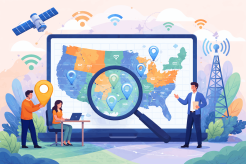Broadband Alternatives For Your Business or Home Internet

The majority of individuals have an alternative internet connection. The connection method you select impacts how a home network must be configured to accommodate network sharing.
Subscriber Line in Digital Format
One of the most common types of internet connection is DSL. DSL uses digital modems to enable high-speed networking over regular phone lines. You may effortlessly share your DSL connection using wired or wireless broadband routers.
DSL is also known as ADSL, ADSL2, or ADSL2+ in various places.
Other Ways to Connect to the Internet
Other types of connectivity are more uncommon or out-of-date, but they are nevertheless accessible for subscription on occasion:
T1 and T3 are the terms telecommunications companies use to refer to leased line network cables. Fractional T1/T3 lines are primarily buried fiber or copper cables that link to the service provider. Individual residential connections are switched over Ethernet cables and installed in some multi-resident dwellings.
Mobile Internet: Access via digital telephones or cellular routers is good, although most plans come with data restrictions.
WiMAX technology enables high-speed wireless internet using base stations similar to those found in cellular networks. Wi-Fi community or mesh networks, which use different technologies, perform a similar function.
Broadband Over Power Line
BPL supports Internet connections via household electricity lines. The technology underpinning power line BPL works similarly to phone line DSL, transmitting internet traffic via unused signaling space on the wire.
BPL, on the other hand, is a contentious internet connection option. BPL broadcasts cause interference in power lines, harming other licensed radio transmissions. BPL requires specialized (but not expensive) equipment to connect to a home network.
BPL is not the same as powerline home networking. Although powerline networking creates a local computer network within the home, it does not connect to the internet. On the other hand, BPL uses utility power lines to connect to the internet service provider.
Related Article: 7 Common "Can't Connect to the Internet" Problems and Solutions
Internet via Satellite
Satellite internet is provided by companies such as Hughes and Viasat. Internet connections can be made over a satellite link using an exterior-mounted mini-dish and a proprietary digital modem inside the home, similar to satellite television services.
Satellite internet can cause network problems. Some online services, such as VPNs and online gaming, may not work over satellite connections, and satellite modems may not work with broadband routers.
Satellite internet subscribers typically seek the highest possible bandwidth in areas where cable and DSL are unavailable.
Digital Network for Integrated Services
Before DSL became widely available in the 1990s, ISDN internet served many consumers who wanted DSL-like service. ISDN uses telephone lines and, like DSL, allows voice and data traffic to flow simultaneously. Furthermore, ISDN offers two to three times the speed of conventional dial-up connections. ISDN networking in the home is similar to dial-up networking.
ISDN is only a feasible choice for those wishing to extract extra performance from their phone lines if DSL is unavailable due to its comparatively high cost and limited performance compared to DSL.
Internet Access via Dial-Up
Dial-up, once the world's standard for internet network connections, has been mostly superseded by higher-speed alternatives. Dial-up connections use regular phone lines, but unlike DSL, they take over the wire, preventing simultaneous voice conversations.
With dial-up internet, most home networks use Internet Connection Sharing solutions. Dial-up routers are difficult to come by, expensive, and, in general, ineffective when dealing with such a poor internet connection.
Dial-up internet access is most utilized in sparsely populated areas when cable and DSL internet access are unavailable. Dial-up is a reliable secondary access method for travelers and individuals with unreliable primary internet services.
Internet via Cable Modem
A cable modem, like DSL, is a type of internet connection. Cable internet uses cable television conduits rather than telephone lines to connect to the internet, but the same broadband routers that share DSL internet connections also operate with cable.
In the United States, cable internet is more popular than DSL, but the opposite is true in certain nations.
Related Posts

Tue, Dec 23, 2025 10:40 PM
cheap internet plansYour Upload Speed Might Be Slowing You Down—Here’s Why
Discover why your upload speed may be slowing down and how to fix it. Learn tips to improve your internet performance and avoid frustrating delays

Tue, Dec 23, 2025 2:15 AM
Internet BundlesDecoding Internet Coverage Maps: Tips and Insights
coverage map is a starting point — not the final answer. Combining map data with local feedback, independent tools, and personal testing gives you a far clearer picture of your true internet options.

Mon, Dec 22, 2025 10:57 PM
cheap internet plansAre Physical SIM Cards Becoming Obsolete?
Are physical SIM cards being replaced by eSIM technology? Learn how eSIM works, its benefits, limitations, and what it means for mobile users.

Mon, Dec 22, 2025 10:46 PM
mobile phone plansTop Security Tips for Prepaid & Telecom Apps
Learn essential security tips for using prepaid and telecom apps safely. Protect your data, prevent fraud, and enjoy secure mobile transactions.

Fri, Dec 19, 2025 4:36 AM
SafetyEasy Ways to Keep Your Video Calls Secure
Learn practical ways to secure your video conferencing apps and protect your calls from unwanted access, cyberattacks, and privacy risks.